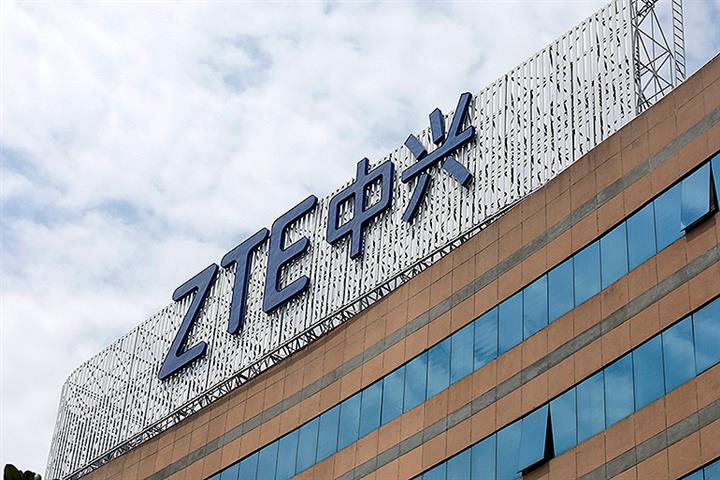 ZTE Falls After Quarterly Profit Slump, Unit’s Power Batteries Led to WM Motor Fires
ZTE Falls After Quarterly Profit Slump, Unit’s Power Batteries Led to WM Motor Fires(Yicai Global) Oct. 29 -- ZTE's stock price tumbled after the Chinese tech company said third-quarter earnings plunged and it emerged that a unit was responsible for some of the power batteries believed to have sparked fires in electric cars made by WM Motor Technology.
Shenzhen-based ZTE [SHE: 000063] fell as much as 5.8 percent to CNY32.52 (USD4.80) this morning, the lowest since Sept. 11. The stock ended the day 4.1 percent lower at CNY33.08.
Net profit plunged 68 percent to CNY850 million (USD126.3 million) in the three months ended September from a year ago due to higher overheads and carrier network costs, ZTE said after the market closed yesterday. But revenue jumped 37 percent to CNY26.9 billion (USD4 billion) because of its increasingly popular carrier network services, the firm said.
It also emerged today that some of the power batteries used in a batch of cars new energy vehicle startup WM Motor is recalling due to autoignition safety concerns came from a wholly owned subsidiary, ZTE Gaoneng Technology.
The recall affects 1,282 EX5 sport-utility vehicles produced between June 8 and Sept. 23 this year that are equipped with ZNP3914895A-75A batteries, according to a statement uploaded yesterday to the website of the State Administration of Market Regulation.
Public information shows that ZTE Gaoneng made and supplied ZNP3914895A-75A batteries to WM Motor.
Four Fires
There have been four fires this month related to WM Motor’s EX5. Two EX5 taxis spontaneously caught fire on Oct. 5 and 13 in Shaowu city, Fujian province. Then on Oct. 19, another EX5 ignited in Taizhou, Jiangsu province, while one more burst into flames in Beijing two days ago.
The Shaowu cases involved batteries from ZTE Gaoneng, but the model that burst into flames in Beijing did not, the company said in a statement yesterday. It did not say whether ZTE Gaoneng batteries were involved in the fire in Taizhou.
Shanghai-based WM Motor also revealed the cause of the incidents. Impurities mixed during the production process could in extreme cases cause the battery core to short-circuit, leading the thermal heat of the power battery unit to spiral out of control and create a fire risk.
Impurity control in the core manufacturing process of batteries is quite difficult, a person at a Chinese battery maker who did not want to be identified told Yicai Global. It can be said that a firm’s impurity control capability is a key indicator of the supplier’s production capacity.
ZTE Gaoneng has supplied batteries to around 2,300 WM Motor vehicles, the person said, citing data.
“Trial-produced lithium batteries are generally great in quality, but mass-produced ones have many problems,” said Wu Hui, general manager of the research department at China YiWei Institute of Economics. “Manufacturers need time to build their equipment and production process control capability.”
ZTE did not start to position itself in the lithium battery sector too late, but ZTE Gaoneng is still a new firm lacking production experience, Wu told Yicai Global.
Formed in 2016, ZTE Gaoneng has a battery plant in Wuhan, central China’s Hubei province. The plant’s Phase I, which went into operation in October 2018, has an annual capacity of 1 gigawatt-hour, and the second and third phases, when completed, are expected to raise the capacity to 8 GWh, public information shows.
New Share Sale
Shares of ZTE also fell after the telecoms equipment giant announced a plan to take full control of its chip-making unit with funds partly raised from the issue of new shares.
In the same statement as its earnings yesterday, ZTE said it intends to sell new shares and raise funds to buy the 18.9 percent of chipmaker ZTE Microelectronics Technology that it does not already own for between CNY541 million and CNY2.6 billion (USD80.7 million and USD388 million).
Formed in 2003, ZTE Microelectronics designs and produces baseband processors for smartphones and base station equipment. It made more than CNY7.6 billion in revenue last year. In 2017, the parent company spent a sum equal to more than 10 percent of its chip budget to buy products from the unit.
ZTE Microelectronics’ self-developed 7nm chips are used in base stations for fifth-generation wireless networks, ZTE Vice President Li Hui said at a conference earlier.
A focus on equipment needed to upgrade to 5G networks may brighten up the company's prospects. The acquisition will help consolidate ZTE's core competitiveness and further enhance its profitability and shareholder return, the firm added.
By the end of September, ZTE had won 55 commercial 5G contracts worldwide and had launched 5G cooperation with more than 90 global carriers, covering more than 500 industry partners.
Editors: Zhang Yushuo, Tang Shihua, Emmi Laine, Peter Thomas